Lacquer box with suzuribako by Kamei Jikisai II
Japan, Meiji period, 1868 - 1912
A rectangular tiered box and cover of Nando type, the top section containing a writing box (suzuribako). The exterior sides are decorated with an all-over wave design in togidsahi technique in yellow, blue, green and speckled lacquer. The suzuribako is fitted with a rectangular water dropper (suiteki) with a wave design and a rectangular ink slab (suzuki). The inside of the lid is decorated in gold on a black ground with a flight of stylised plovers (chidori). The rims are covered in silver and the box and lid are held together with purple ribbons issuing from copper rings attached to the side of the box. The box is contained within its original wooden storage box (tomobako). The top of the lid of the tomobako is inscribed Togidashi nami makie and Onando suzuri (Lacquer ink writing box of the Nando type). The interior of the lid of the tomobako is inscribed Heian Jikisai saku (made by Jikisai, Kyoto] and carries the seal of the artist.
Not much is known about the artist Kamei Jikisai II other than that he was born in 1861 as the son of Kamei Jikisai I (1821 – 1896). A Nando-type box is a box that combines writing and paper together in stacked layers. In this box, the top layer holds the writing box (suzuribako) whilst the bottom part is destined to hold paper (ryoshibako). The motif of plovers in the lid is highly auspicious: plovers are small birds that live in flocks near water, a popular design motif either alone or combined with waves. The bird is an auspicious symbol associated with longevity because its cry ‘chiyo’ is a homonyn for ‘chiyo, meaning “One Thousand Generations (for the Emperor)”.


